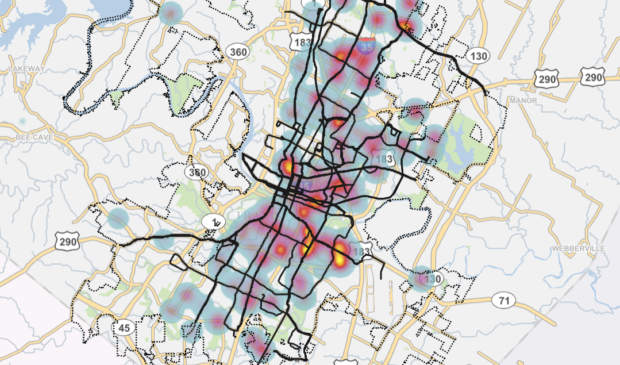City unveils affordable housing and transit dashboard ahead of Project Connect
Wednesday, September 9, 2020 by
Ryan Thornton With a historic investment in public transit and affordable housing on the Nov. 3 ballot, the Neighborhood Housing and Community Development Department has launched an interactive map to track proximity of income-restricted housing stock to potential stations along the city’s transportation priority network.
The tool, which was demonstrated to City Council’s Housing and Planning Committee on Tuesday morning, is now live and will soon be posted to the city’s housing website, according to Mandy De Mayo, community development administrator for NHCD.
The dashboard reflects distances between the 26,663 income-restricted units already on the ground across the city and the proposed transit network. It shows that a quarter of existing affordable units are within a quarter-mile walk of a proposed Project Connect station and 58 percent are within a half-mile.
“We’ve been so focused on the $300 million that’s been added to Project Connect – which is a huge investment – it’s really important to note … how much is already being done in that regard,” Mayor Steve Adler said.
According to the Austin Strategic Mobility Plan, between a quarter-mile and a half-mile – or five to 10 minutes – is a “typical distance to walk” to a transit stop as long as there are safe and accessible pedestrian facilities along the way. The dashboard, however, reflects only distances, not the existence or condition of sidewalks.
“To be clear, it’s a work in progress,” De Mayo said. “We’re going to be updating the information as units come online. It will be constantly updated and we’re eager for feedback as well, for changes that folks would like to see.”
Users may also view affordable housing maps showing:
- housing with city funding or development incentives
- housing without city funding or development incentives
- units in the development or pre-development stages
- city-owned land with plans for affordable housing
- properties with affordability periods expiring by 2025
- units in areas at risk of displacement or gentrification per the Uprooted report
The map shows that 13,276 units – about half of the city’s affordable housing stock – are in areas at risk of displacement. If Project Connect is approved in November, the city intends to use $300 million of the $7.1 billion project to protect neighborhoods from further economic pressures that can result from large public transportation investments.
In an online post Monday, Austin Justice Coalition called for a robust public engagement and planning process around Project Connect that operates through a framework of mobility justice, so communities may benefit from new projects like mass transit. AJC calls for long-term displacement mitigation strategies like land trusts and renter protections as well as the right to remain and return alongside Project Connect.
On top of the 11,123 rental units with city funding or development incentives, NHCD has another 11,239 units in development or pre-development stages and 55 percent of those are located within a half-mile of a proposed Project Connect stop.
This would roughly double the number of the housing department’s affordable units, but the city is also losing affordable housing as affordability periods expire. Over the next five years, affordability periods will expire for 4,688 units, 47 percent of which are within a quarter-mile walk of a proposed transit stop.
“That’s part of why as part of the proposition on the ballot we’ve included the $300 million for anti-displacement work,” Council Member Greg Casar said. “My hope is that we do actually double the amount of affordable housing the city provides here in the next few years. That would be a huge feat.”
De Mayo said not all of the 4,688 affordable units will be lost in 2025. The city expects some properties to choose to extend the affordability periods while others will do so as part of the low-income housing tax credit program. Some of the buildings are owned by the city and the affordability periods will be renewed as soon as they expire. For the others, De Mayo said the department’s “first step” is to identify the properties early enough to invest in the extension of the affordability period.
The Austin Monitor’s work is made possible by donations from the community. Though our reporting covers donors from time to time, we are careful to keep business and editorial efforts separate while maintaining transparency. A complete list of donors is available here, and our code of ethics is explained here.
You're a community leader
And we’re honored you look to us for serious, in-depth news. You know a strong community needs local and dedicated watchdog reporting. We’re here for you and that won’t change. Now will you take the powerful next step and support our nonprofit news organization?



